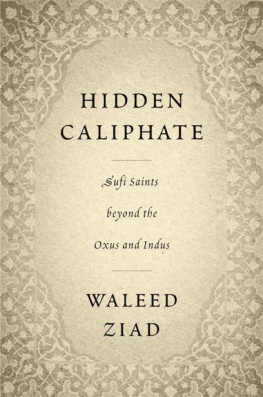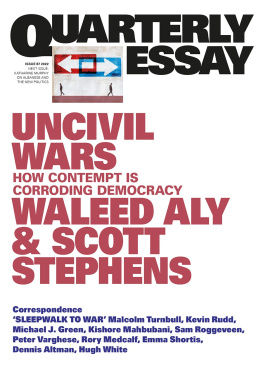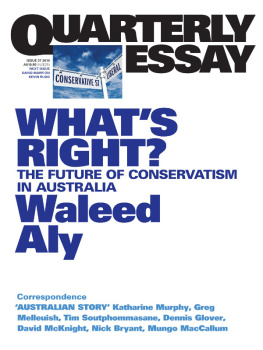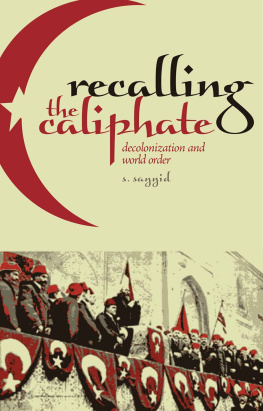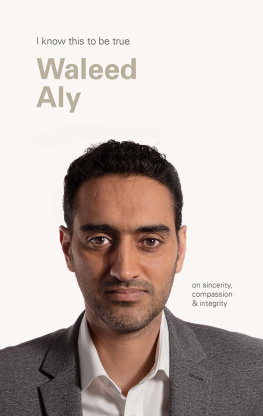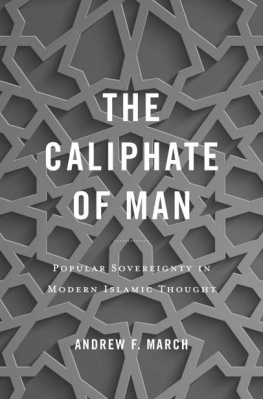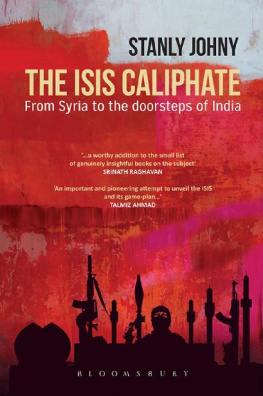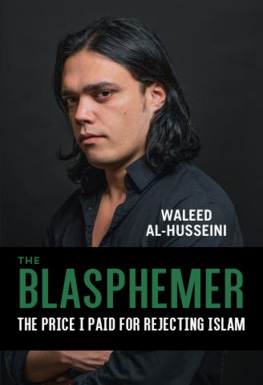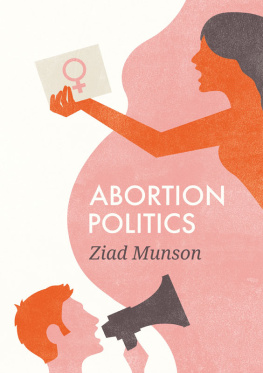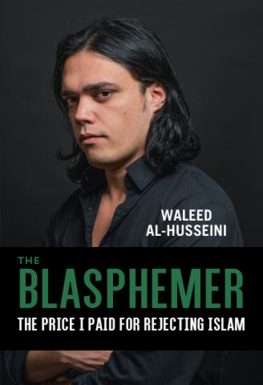Waleed Ziad - Hidden Caliphate
Here you can read online Waleed Ziad - Hidden Caliphate full text of the book (entire story) in english for free. Download pdf and epub, get meaning, cover and reviews about this ebook. year: 2021, publisher: Harvard University Press, genre: Religion. Description of the work, (preface) as well as reviews are available. Best literature library LitArk.com created for fans of good reading and offers a wide selection of genres:
Romance novel
Science fiction
Adventure
Detective
Science
History
Home and family
Prose
Art
Politics
Computer
Non-fiction
Religion
Business
Children
Humor
Choose a favorite category and find really read worthwhile books. Enjoy immersion in the world of imagination, feel the emotions of the characters or learn something new for yourself, make an fascinating discovery.
- Book:Hidden Caliphate
- Author:
- Publisher:Harvard University Press
- Genre:
- Year:2021
- Rating:3 / 5
- Favourites:Add to favourites
- Your mark:
- 60
- 1
- 2
- 3
- 4
- 5
Hidden Caliphate: summary, description and annotation
We offer to read an annotation, description, summary or preface (depends on what the author of the book "Hidden Caliphate" wrote himself). If you haven't found the necessary information about the book — write in the comments, we will try to find it.
Hidden Caliphate — read online for free the complete book (whole text) full work
Below is the text of the book, divided by pages. System saving the place of the last page read, allows you to conveniently read the book "Hidden Caliphate" online for free, without having to search again every time where you left off. Put a bookmark, and you can go to the page where you finished reading at any time.
Font size:
Interval:
Bookmark:
Hidden Caliphate

Copyright 2021 by the President and Fellows of Harvard College
All rights reserved
Printed in the United States of America
First printing
Design: Graciela Galup
Cover art: Getty Images
978-0-674-24881-6 (cloth)
978-0-674-26937-8 (EPUB)
978-0-674-26938-5 (PDF)
The Library of Congress has cataloged the printed edition as follows:
Names: Ziad, Waleed, 1980 author.
Title: Hidden caliphate : Sufi saints beyond the Oxus and Indus / Waleed Ziad.
Description: Cambridge, Massachusetts : Harvard University Press, 2021. | Includes bibliographical references and index.
Identifiers: LCCN 2021012943 | ISBN 9780674248816 (cloth)
Subjects: LCSH: Muslim saintsAsia, CentralHistory. | Muslim saintsAsia, CentralBiography. | Muslim saintsPakistanHistory. | Muslim saintsPakistanBiography. | SufismPolitical aspectsHistory. | CaliphateHistory. | Islam and politicsHistory. | Dawah (Islam)History.
Classification: LCC BP189.4 .Z53 2021 | DDC 297.6/10958dc23
LC record available at https://lccn.loc.gov/2021012943
For my family
As terms, personal names, and place names may be pronounced in various ways in the source languages, this book employs a simplified transliteration system that privileges readability, modified from the International Journal of Middle East Studies guidelines. Commonly used words like Sufi, khan, amir, and ulama are not translated or transliterated. Names of individuals and works of literature are presented without diacritics, while terms in Arabic, Persian, Urdu, Chagatai, or Pashto appear with minimal diacritical marks to reflect, where possible, pronunciation according to the language and genre of the text or oral history. Place names are represented in their common modern forms.
Hidden Caliphate

I N 1821, the English explorer William Moorcroft reached Ladakh, a Buddhist mountain kingdom bordering Tibet to the north. Moorcroft, who began his career as a veterinary surgeon, was recruited by the East India Company to locate superior horse breeds for the Companys use and needed access to the fabled horse markets of Bukhara. He was accompanied by Mir Izzatullah, his talented secretary, whose family had migrated from Bukhara to northern India two generations earlier.
We might have thought that Moorcrofts journey depended on the goodwill of political powerbrokers who controlled (in theory) the borders and roads. But in fact his journey was made possible by a bin, or hidden, caliphate, a network of Sufi scholar-saints with whom Mir Izzatullah was affiliated. Mir Izzatullah suggested that they approach a certain Shah Niyaza Sufi born in a princely family of Tashkent, who had migrated first to Kashmir, then Yarkand in China. Shah Niyaz had been dispossessed of his Kashmiri properties after the Sikh occupation of 1819 and sought refuge in the relatively peaceful region of Ladakh, where he became a confidant of the Buddhist chief minister. Mir Izzatullahs suggestion proved fruitful: Shah Niyaz graciously offered to refer Moorcroft to Mian Fazl-i Haqq of Peshawar, the son and spiritual successor of one of Peshawars greatest saints, who could facilitate his journey.
From Ladakh, Moorcroft traveled on horseback about 1,300 kilometers westward to Peshawar, via Kashmir and northern Punjab, where he met Fazl-i Haqq, an approachable, mild-mannered holy man who proved eager to help. Fortuitously, Fazl-i Haqq himself needed to travel to Bukhara to meet with the king, Amir Hayder, who was not just a devoted disciple of his father Fazl Ahmad Peshawari but had been appointed as one of his spiritual deputies. Moorcroft seized the opportunity. He offered to finance Fazl-i Haqqs journey to Bukhara, in return for good references to the various rulers en route, who all venerated the Peshawari saint. Fazl-i Haqq agreed. Some weeks later, however, due to a combination of mischief and miscommunication, Moorcroft found himself in a bind, detained by Mir Murad Beg of Qunduz, the famously obstinate ruler of an autonomous state south of the Amu Darya, known to Europeans as the Oxus River. Eventually, again through Fazl-i Haqqs network, Moorcroft was referred to Khwaja Qasim Jan, the venerated Sufi patriarch of Qunduz, who had considerable clout with the mir, who happened to be his son-in-law. After prolonged deliberations, the Qunduzi Sufi managed to negotiate Moorcrofts release in return for a payment to the mir. The Englishman finally succeeded in reaching Bukhara, becoming one of the few Europeans to have ventured into this legendary metropolis.
B ut this book is not about Moorcroft. In fact, he is no more than an incidental character in a much larger story that has been overlooked because, both during and after the nineteenth century, European writings on the region across which Moorcroft traveled have only been concerned with religious figures insofar as they seemed relevant to colonial interests.
Hidden Caliphate views this world from an entirely different perspective, that of the religious network that made Moorcrofts journey possible in a time of political fragmentation. It reveals an interconnected Persianate cosmopolis that persisted into the early twentieth century. This sphere of exchange stretched across the Indus and Amu Darya well into the Inner Asian Steppes and western China: regions mediated through a shared Persian cultural-linguistic tradition and historical memory even as British, Russian, and Chinese imperial expansion encroached.
Each of the real protagonists of my storyMir Izzatullah, Shah Niyaz, Khwaja Qasim Jan, Fazl-i Haqq, Bukharas king Amir Hayder, and thousands morebelonged to a vast, intricate network of scholar-mystics known as the Naqshbandi-Mujaddidi (or simply Mujaddidi, literally meaning revivalist) order. Each had undergone a rigorous course of education and spiritual training spanning well over a decade at premier institutions of higher learning in cities like Bukhara, Kabul, Peshawar, and Delhi. The Mujaddidis followed a comprehensive exoteric curriculum ranging from Persian poetry, ethics, and logic to medicine and jurisprudence, before graduating to the higher esoteric or hidden sciences. Through carefully crafted courses on meditation, they learned to activate metaphysical energy centers mapped onto the physical body. These practices enabled an inward spiritual journey toward God and a return to the created world. With the knowledge and wisdom they gained, they became fit to lead others in spiritual development as well as worldly affairs.
Mujaddidi scholar-saints composed one of the principal corporate groups in regions as disparate as Kashgar and Kazan. In fact, their bin khilfat was arguably the most extensive Muslim scholastic-religious network of the seventeenth to early twentieth centuries. The Mujaddidis fused Persian, Arabic, and vernacular literary traditions; mystical virtuosity; popular religious practices; and the urban scholastic domain into a unified, yet flexible, articulation of Islam that provided coherence to diverse Muslim communities across wide-ranging territory. They also articulated some of the most effective social responses to the decline of Muslim political power and the ascendance of European colonialism; by the late nineteenth century, they had even inspired the regions principal Muslim reformist movements.
This book asks how the Mujaddidis were able to establish this remarkable parallel form of popular leadership, which transcended and outlived contemporary political structures, surviving to the present day. It follows the emergence and evolution of their trans-Asiatic networks, which bridged intellectual, economic, and religious domains across the fragile states of the eighteenth and nineteenth centuries, on both sides of the Indus River and Amu Darya. At the same time, it shows how the contemporary Persianate world orderits cosmopolitan urbanites, pastoralists, and agriculturalists; its petty princes, tribal chiefs, and landed gentry alikerelied on this overarching network for stability, communication, and mediation both between competing parties and between the visible and invisible realms.
Next pageFont size:
Interval:
Bookmark:
Similar books «Hidden Caliphate»
Look at similar books to Hidden Caliphate. We have selected literature similar in name and meaning in the hope of providing readers with more options to find new, interesting, not yet read works.
Discussion, reviews of the book Hidden Caliphate and just readers' own opinions. Leave your comments, write what you think about the work, its meaning or the main characters. Specify what exactly you liked and what you didn't like, and why you think so.

